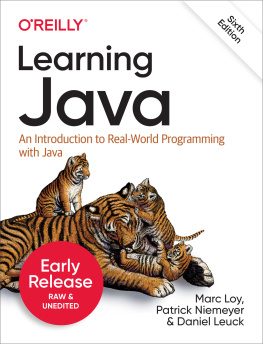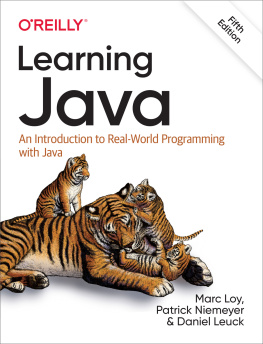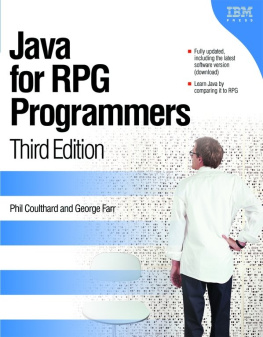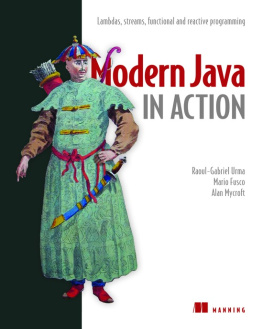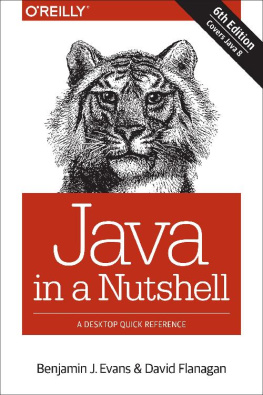Chapter 1. A Modern Language
A Note for Early Release Readers
With Early Release ebooks, you get books in their earliest formthe authors raw and unedited content as they writeso you can take advantage of these technologies long before the official release of these titles.
This will be the 1st chapter of the final book. Please note that the GitHub repo will be made active later on.
If you have comments about how we might improve the content and/or examples in this book, or if you notice missing material within this chapter, please reach out to the author at .
The greatest challenges and most exciting opportunities for software developers today lie in harnessing the power of networks. Applications created today, whatever their intended scope or audience, will almost certainly run on machines linked by a global network of computing resources. The increasing importance of networks is placing new demands on existing tools and fueling the demand for a rapidly growing list of completely new kinds of applications.
As users, we want software that worksconsistently, anywhere, on any platformand that plays well with other applications. We want dynamic applications that take advantage of a connected world, capable of accessing disparate and distributed information sources. We want truly distributed software that can be extended and upgraded seamlessly. We want intelligent applications that can roam the cloud for us, ferreting out information and serving as electronic emissaries. We have known for some time what kind of software we want, but it is really only in the past few years that we have begun to get it.
The problem, historically, has been that the tools for building these applications have fallen short. The requirements of speed and portability have been, for the most part, mutually exclusive, and security has been largely ignored or misunderstood. In the past, truly portable languages were bulky, interpreted, and slow. These languages were popular as much for their high-level functionality as for their portability. Fast languages usually provided speed by binding themselves to particular platforms, so they met the portability requirement only halfway. There were even a few languages that nudged programmers to write better, more secure code, but they were primarily offshoots of the portable languages and suffered from the same problems. Java is a modern language that addresses all three of these fronts: portability, speed, and security. This is why it remains a dominant language in the world of programming almost three decades after its introduction.
Enter Java
The Java programming language was designed to be a machine-independent programming language that is both safe enough to traverse networks and powerful enough to replace native executable code. Java addresses the issues raised here and played a starring role in the growth of the internet, leading to where we are today.
Initially, most of the enthusiasm for Java centered on its capabilities for building embedded applications for the web, called applets. But in the early days, applets and other client-side graphical user interfaces (GUIs) written in Java were limited. Today, Java has Swing, a sophisticated toolkit for building GUIs. This development has allowed Java to become a viable platform for developing traditional client-side application software, although many other contenders have entered this crowded field.
Even more important, however, is that Java has become the premier platform for web-based applications and web services. These applications use technologies such as the Java Servlet API, Java Web Services, and many popular open source and commercial Java application servers and frameworks. Javas portability and speed make it the platform of choice for modern business applications. Java servers running on open source Linux platforms are at the heart of the business and financial world today.
This book will show you how to use Java to accomplish real-world programming tasks. In the coming chapters well introduce you to a wide selection of Java features, including text processing, networking, file handling, and building desktop applications with Swing.
Javas Origins
The seeds of Java were planted in 1990 by Sun Microsystems patriarch and chief researcher Bill Joy. At the time, Sun was competing in a relatively small workstation market, while Microsoft was beginning its domination of the more mainstream, Intel-based PC world. When Sun missed the boat on the PC revolution, Joy retreated to Aspen, Colorado, to work on advanced research. He was committed to the idea of accomplishing complex tasks with simple software and founded the aptly named Sun Aspen Smallworks.
Of the original members of the small team of programmers Joy assembled in Aspen, James Gosling will be remembered as the father of Java. Gosling first made a name for himself in the early 1980s as the author of Gosling Emacs, the first version of the popular Emacs editor that was written in C and ran under Unix. Gosling Emacs was soon eclipsed by a free version, GNU Emacs, written by Emacss original designer. By that time, Gosling had moved on to design Suns Network extensible Window System (NeWS), which briefly contended with the X Window System for control of the Unix GUI desktop in 1987. Although some people would argue that NeWS was superior to X, NeWS lost because Sun kept it proprietary and didnt publish source code, while the primary developers of X formed the X Consortium and took the opposite approach.

